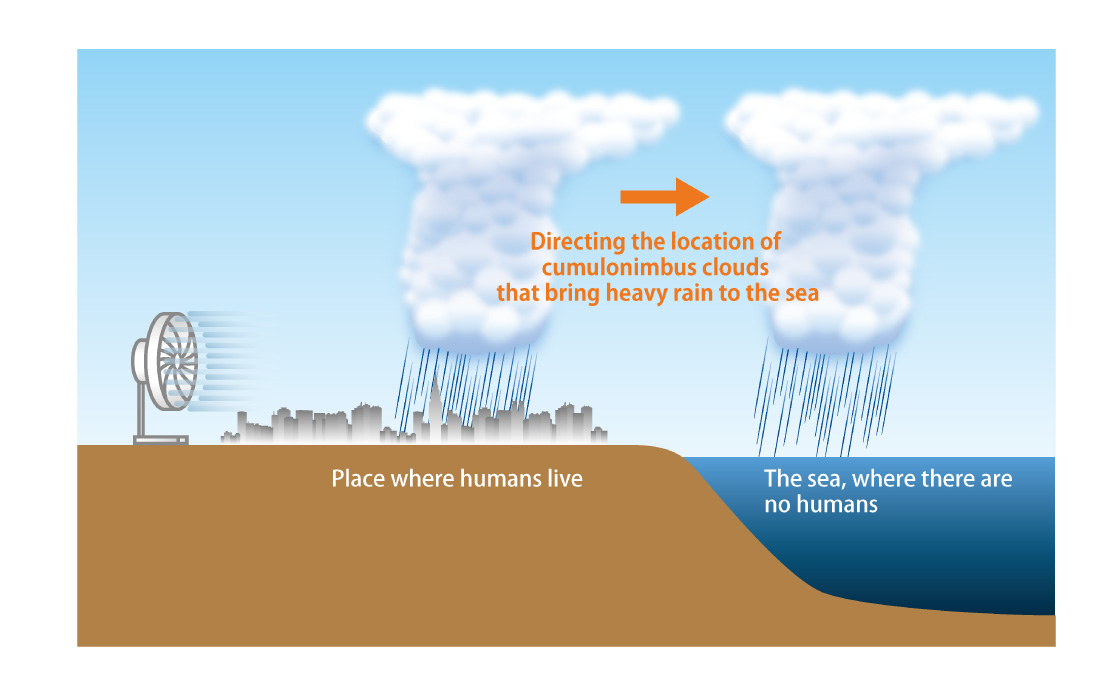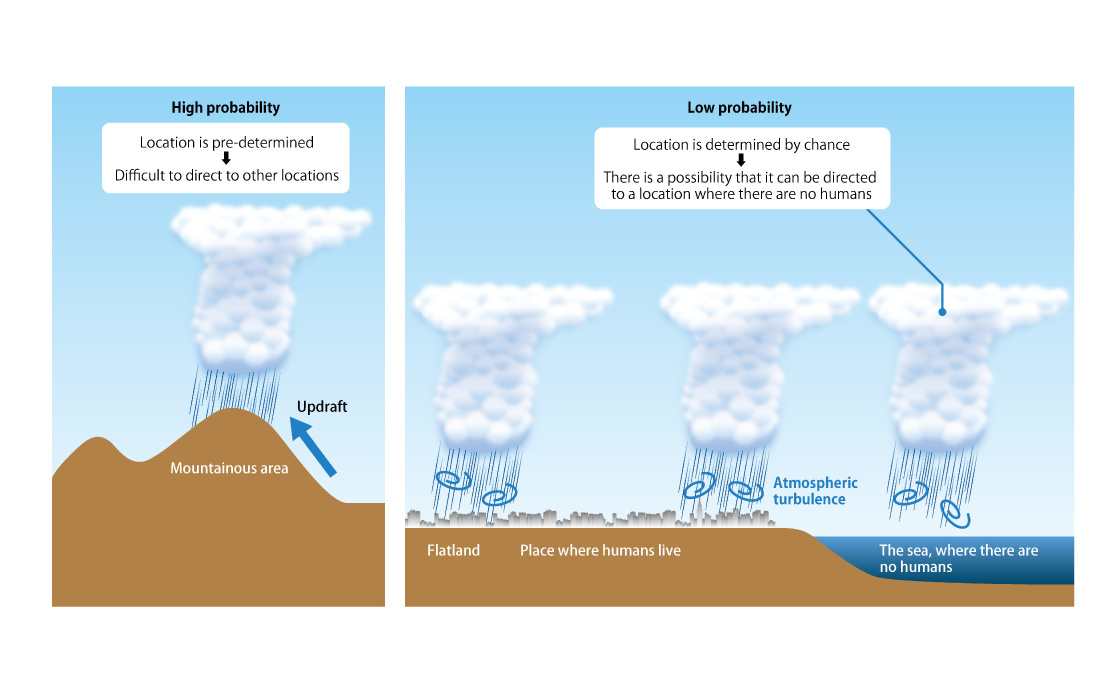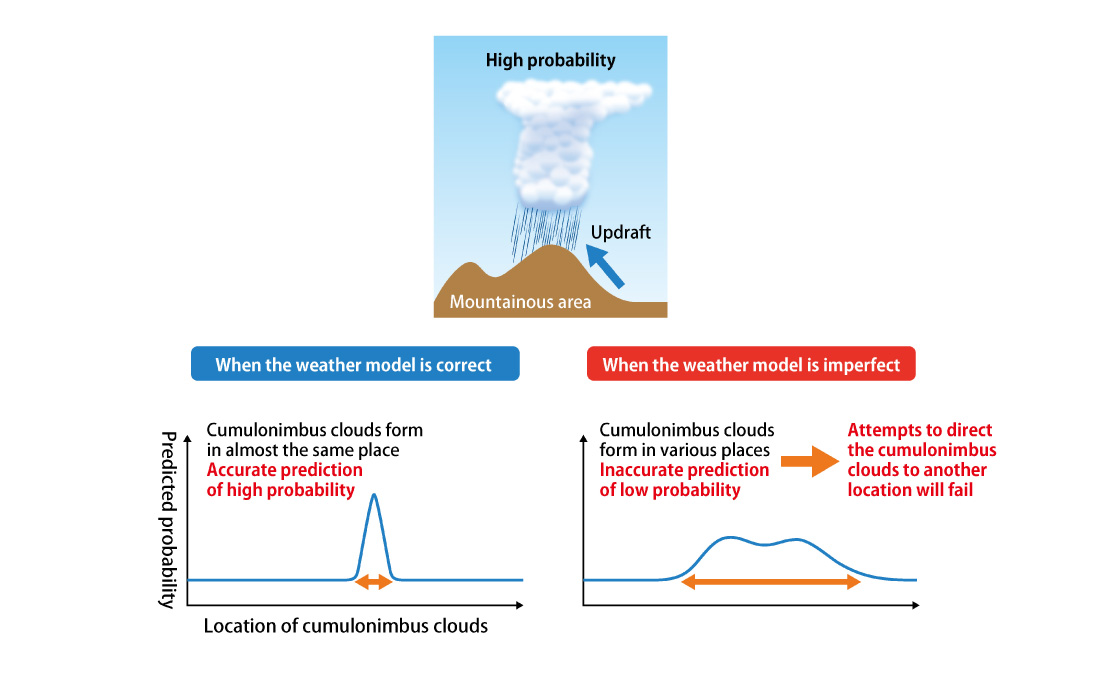Research overview
Our goal was to gain control over extreme weather events that bring heavy rain and gusts, such as cumulonimbus clouds and tornadoes, so as to prevent wind and flood damage.
For example, when cumulonimbus clouds are deterministically (inevitably) formed at a specific location under certain weather conditions, it is difficult to artificially direct them to a place with no humans present. If the opposite holds true, then a method to gain control over their occurrence time and/or precipitation amount is needed.
Thus, to select the optimal control method requires accurately estimating the probability of the phenomena that caused wind and flood damage as well as determining whether their occurrence location and time, precipitation amount, and wind speed occur deterministically or by chance.
We have developed a new atmospheric simulation model for that purpose.
Details of research
Here is a potential news article approximately 30 years from now:
In June 2050, a forecast that a "linear precipitation zone," in which cumulonimbus clouds continuously form in the same place, would occur in Northern Kyushu, was issued following last year. Long-term heavy rains can cause river water to flow over embankments and into residential areas, leading to major wind and flood damage. Therefore, a large amount of dry ice was dropped from an airplane toward the developing cumulonimbus clouds. As a result, the development of cumulonimbus clouds was suppressed, the precipitation amount decreased, the rivers did not overflow, and major damage was avoided. ——
We aimed to develop a technology to control cumulonimbus clouds, as depicted in this news from the year 2050, and protect human lives from wind and flood damage caused by extreme weather events, such as linear precipitation zones and guerrilla rainstorms.
Due to global climate change, the frequency of heavy rain and the amount of precipitation per event are expected to rise in Japan. There is a risk that wind and flood damage cannot be prevented by such methods as issuing highly accurate forecasts to urge people to evacuate and to determine the need to raise river embankments. Therefore, we believe that a novel technology is needed to control extreme weather phenomena that cause wind and flood damage.
In fact, experiments were conducted to control weather in order to reduce damage. For example, in the 1960s, experiments were conducted to weaken hurricanes in the United States. It was reported that, by spraying a substance called silver iodide to a typhoon, the wind speed immediately weakened by 30%. However, it was unclear whether the weakened wind speed occurred due to the spraying of silver iodide or by chance.
(Project STORMFURY: A Scientific Chronicle 1962-1983, Bull. Amer. Meteorol. Soc. 66, 505-514.)
After that, owing to the improved accuracy of the “Atmospheric Simulation Models,” which can reproduce typhoons and rain with high accuracy, it has become known that typhoons and cumulonimbus clouds could be controlled.
Selection of the control method requires “estimation of probability”
For example, if we can shift the location of cumulonimbus clouds away from human communities to the sea with no people present, we can prevent wind and flood damage.
The difficulty in shifting cumulonimbus clouds arises from complex terrain conditions, such as mountainous area. Cumulonimbus clouds are caused by updrafts that carry warm moist air near the ground surface to the upper air layer, where water vapor contained in the air is cooled and becomes countless water and ice particles, thereby forming clouds. Cumulonimbus clouds containing large amounts of water carried by strong updrafts cause heavy rains.
How do updrafts occur? When the wind blows toward a mountain, the air rushes up the mountain and creates an updraft. Therefore, cumulonimbus clouds tend to be generated in specific locations in mountainous areas, depending on the wind direction.
Even on flat land, when cold air flows over warm air near the surface, or when the ground surface is warmed by sunlight, warm air becomes lighter than cold air; thus, updraft occurs, and cumulonimbus clouds form. In such cases, cumulonimbus clouds can occur at various locations rather than specific locations. By simply changing the weather conditions even slightly, such as the wind direction, it may be possible to choose a place with no humans present from the various possibilities.
It can be said that the location where cumulonimbus clouds form, for example, tends to be pre-determined in mountainous areas but occurs by chance in flatlands. As it is difficult to shift the location of cumulonimbus clouds when their location is fixed, another method, such as cooling the warm air with dry ice to weaken the updraft and reduce precipitation amount, may be suitable. On the contrary, if their location is random, it may be more effective to shift the location where the cumulonimbus cloud occurs by moving the place where the updraft occurs with a huge fan rather than changing the precipitation amount.
Thus, when controlling cumulonimbus clouds that can cause meteorological and hydrological disasters, it is necessary to consider which one of the following is best or most appropriately controlled: occurrence location and timing, precipitation amount, and wind speed. This in turn calls for knowing whether they occur deterministically or by chance. A representation of how likely it is for what kind of state (for example, the location of occurrence) to occur for phenomenon of interest is called “probability distribution”. The degree of probability distribution, whether the distribution is narrow and occurs at a highly probable specific location or wide and occurs at various locations, is the “probability” referred to in the project title. Therefore, it is important to estimate this probability for the purposes of weather control.
Weather control may sound as if humans can control nature. Instead, when the probability of a certain weather phenomenon is low, that is, when various possibilities and options are wide, we aim to artificially (and slightly) change the conditions to direct the phenomenon to a state within the possibilities so that expected damage can be reduced. The estimation of probability is aimed at predicting how wide the options are and how likely it is to artificially induce a change.
Create a new atmospheric simulation model to estimate probability with high accuracy.
The probability of the weather phenomenon can be understood with high accuracy if we can gauge how much its occurrence location and time, precipitation amount, and wind speed respond to a gradual change in weather conditions, such as air temperature, sea surface temperature, and atmospheric pressure distribution. However, it is impossible to conduct such experiments in a real environment.
Instead, we have developed an atmospheric simulation model to stochastically reproduce the evolution of cumulonimbus clouds while gradually changing the conditions. From the repeated simulation results, we can estimate that, if the phenomenon occurs at almost the same location in all simulations, the probability of the location is high, whereas if it occurs at various locations, its probability is low.
However, this method has a significant problem. Current weather models are imperfect in that they cannot accurately calculate occurrence location and time, precipitation amount, and wind speed of cumulonimbus clouds. For example, even if cumulonimbus clouds are to be actually formed at a fixed position, there would be a risk of large errors in the simulation results about cumulonimbus clouds forming at various positions. Based on these simulation results, attempts to shift the location of cumulonimbus clouds will not be successful.
Why are the current weather models imperfect? Clouds are formed by the collection of countless water and ice particles. Thus, to reproduce clouds, it is necessary to calculate the behaviors of countless water and ice particles based on physical laws. However, the amount of calculation required is enormous, and even the fastest computer cannot complete this calculation. Therefore, when the current atmospheric simulation model is used to reproduce clouds, the amount of computation is reduced by incorporating various simplified assumptions as follows:
"Empirically, in the case of such temperature, water vapor, and wind conditions, such clouds develop," and "let the distribution of fine particles in the air (aerosols) required for cloud generation be uniform." Many such simplifications are included in the weather model and are one of the causes of errors.
The physical laws related to weather phenomena, such as cumulonimbus clouds, are not completely understood. This is another cause of errors.
In the current atmospheric simulations, calculations are performed by dividing the area into grids of several square kilometers. The roughness of the grid is another source of errors. However, there is no guarantee that the accuracy of probability estimation is improved even if the grids are made as small as 1 m2 or less, due to the propagation of errors caused by the imperfect weather models. This is because the current atmospheric simulation models are based on assumptions that hold true only when the model is coarsely divided. Improving the accuracy of probability estimation cannot be achieved by simply improving the existing weather models.
By minimizing such assumptions, we have developed an atmospheric simulation model that is completely different from the conventional computational methods. For example, it allows us to more accurately and efficiently calculate the behaviors of water and ice particles that construct clouds. Then, we check whether or not the developed weather model has improved probability- estimation accuracy, determine the factors that hinder the improvement of accuracy, and proceed with improvement. By following this procedure, we can estimate the probability with high accuracy, select the optimal control method for a certain phenomenon that may cause meteorological and hydrological disasters (e.g., cumulonimbus clouds), and realize a future in which wind and flood damage can be prevented.





